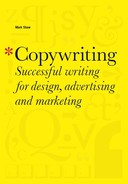Case Study: The Territory Ahead
The Territory Ahead (TTA) is a US private-label clothing and accessory catalog set up in the late 1980s. Mark Boston has been editorial director for the past three years. He explains the attitude and approach they take to writing for their audience, and how they tackle the complexities of their copywriting throughout the catalog.

controlling the TTA tone of voice
Writing a large retail catalog involves many challenges, and maintaining consistency without losing freshness and originality takes a great deal of planning. My objective when I started was to control and develop the tone of voice for the catalog and for the company as a whole.
The Territory Ahead has a fun, conversational tone of voice, with lines packed with personality reflecting the mindset of the independent traveler, such as “Is it ever too soon to be comfortable? Hell, no. Crafted of a slip-on-easy all-cotton rib knit that guarantees warmth and promises silly and happy comfort from sunup to sundown.”
Although we sell our products through our print catalog, website, and retail stores, we decided to use the same style for our print and web messages. The original tone of voice was established by the founder’s wife when the business began. At that time, we sold men’s products and the tone of voice was a little irreverent, poking fun at men in particular. This was a very different approach from that taken by most retailers, and resonated with customers. It proved popular and effective.
The Approach:
giving writers the freedom to express themselves
I have been a copywriter for years and years, but this is my first editorial role. I like it. I was always an in-house writer and I do miss the writing, although I make sure that I get to write some of the copy too.
I take the view that if I’m drawn to something as a customer, I’ll buy it, so I focus on how the copy will appeal to, or draw in, readers. I created a new approach to managing copy based on having one in-house editor who concentrates on women’s copy and another, our previous editorial director, focusing on men’s. All our writers are freelance; many have worked for us for quite a long time. They know what we want and they always deliver it to us.
We do have a tone-of-voice manual, but it isn’t too constraining – I want to see what writers can do when given some freedom, when they bring their experiences to the copy. We don’t want a cookie-cutter approach. We know that our customers are literate and intelligent. They don’t all travel, but they are interested. It’s a “road less traveled” kind of approach – a shared attitude to life.
We see the customer and our shared journey as the focal point of our brand. Everyone who writes for us knows our brand and understands what works and doesn’t work. Every season we choose a different location and create an “editorial packet” full of details and anecdotes about the area. Our copywriters draw on the information to bring their copy to life, and this helps create some consistency without restraining the creative writing.
Our women’s products team includes two guys. Women do bring a different set of experiences when writing about clothes for women, they wear the same items and know what a woman looks for in them – but a few of our male writers also write successfully for women’s products. All of our writers have to pass a copy test, which includes about four products to write about. It’s strange, but many talented writers can’t do the style of writing we need. We don’t want it to be too catalogy or traditional – for example, phrases such as “three reasons to buy.” We look to be more personable, engaging, and aspirational.
There are so many things to accomplish with the writing – it has to inform, engage, create interest, and sell the products – but I believe that it doesn’t really matter how you approach the writing, so long as you get under the skin of your audience. I love the Boden clothes catalog in the UK because it sounds like the first-person voice of the boss or a mate. Achieving this is harder than it looks, and I think it’s very important, especially for The Territory Ahead, not to talk down to readers. We aren’t afraid to be literary and use four-syllable words. We know if our readers don’t get it, they’re likely to look it up.
It’s important to keep a sense of variety. We ensure we get up close and examine merchandise on some pages, revealing textures and showing what we believe in. This will be followed by more heavily merchandised pages. There are two schools of thought on how much to write about products. I don’t subscribe to the idea that the more you put on the page, the more you sell, but others argue the point. Realities of economics mean that we have to fit more products onto the page in order to sell more.
The Result:
the copy is a major part of our brand expression
We get a lot of feedback. Just today I got a card from a customer saying he “enjoyed the story about the sausage in Germany” in our Fall catalog. Some don’t buy clothes, but they still like to read the copy and the way we write reflects this and is very much part of our brand identity. We design our own clothes and use our own voice. Our customers are non-traditional in the way they dress – that’s our niche, and unless the market changes we’ll stay the same.
